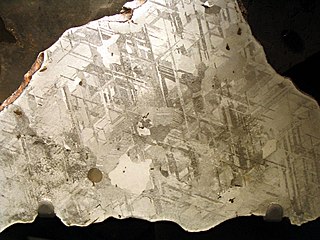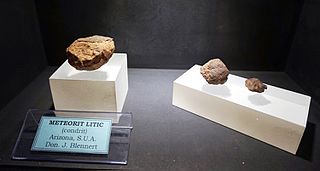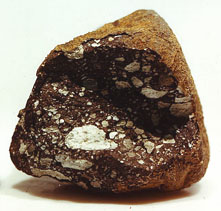Related Research Articles

Kamacite is an alloy of iron and nickel, which is found on Earth only in meteorites. According to the International Mineralogical Association (IMA) it is considered a proper nickel-rich variety of the mineral native iron. The proportion iron:nickel is between 90%:10% and 95%:5%; small quantities of other elements, such as cobalt or carbon may also be present. The mineral has a metallic luster, is gray and has no clear cleavage although its crystal structure is isometric-hexoctahedral. Its density is about 8 g/cm3 and its hardness is 4 on the Mohs scale. It is also sometimes called balkeneisen.

A meteorite is a solid piece of debris from an object, such as a comet, asteroid, or meteoroid, that originates in outer space and survives its passage through the atmosphere to reach the surface of a planet or moon. When the original object enters the atmosphere, various factors such as friction, pressure, and chemical interactions with the atmospheric gases cause it to heat up and radiate energy. It then becomes a meteor and forms a fireball, also known as a shooting star; astronomers call the brightest examples "bolides". Once it settles on the larger body's surface, the meteor becomes a meteorite. Meteorites vary greatly in size. For geologists, a bolide is a meteorite large enough to create an impact crater.

Meteor Crater or Barringer Crater is an impact crater about 37 mi (60 km) east of Flagstaff and 18 mi (29 km) west of Winslow in the desert of northern Arizona, United States. The site had several earlier names, and fragments of the meteorite are officially called the Canyon Diablo Meteorite, after the adjacent Canyon Diablo.

In meteoritics, a meteorite classification system attempts to group similar meteorites and allows scientists to communicate with a standardized terminology when discussing them. Meteorites are classified according to a variety of characteristics, especially mineralogical, petrological, chemical, and isotopic properties.

A lunar meteorite is a meteorite that is known to have originated on the Moon. A meteorite hitting the Moon is normally classified as a transient lunar phenomenon.

A chondrite is a stony (non-metallic) meteorite that has not been modified, by either melting or differentiation of the parent body. They are formed when various types of dust and small grains in the early Solar System accreted to form primitive asteroids. Some such bodies that are captured in the planet's gravity well become the most common type of meteorite by arriving on a trajectory toward the planet's surface. Estimates for their contribution to the total meteorite population vary between 85.7% and 86.2%.

The Haviland Crater, also called the Brenham Crater, is a meteorite crater (astrobleme) in Kiowa County, Kansas.

The Canyon Diablo meteorite refers to the many fragments of the asteroid that created Meteor Crater, Arizona, United States. Meteorites have been found around the crater rim, and are named for nearby Canyon Diablo, which lies about three to four miles west of the crater.

ANSMET is a program funded by the Office of Polar Programs of the National Science Foundation that looks for meteorites in the Transantarctic Mountains. This geographical area serves as a collection point for meteorites that have originally fallen on the extensive high-altitude ice fields throughout Antarctica. Such meteorites are quickly covered by subsequent snowfall and begin a centuries-long journey traveling "downhill" across the Antarctic continent while embedded in a vast sheet of flowing ice. Portions of such flowing ice can be halted by natural barriers such as the Transantarctic Mountains. Subsequent wind erosion of the motionless ice brings trapped meteorites back to the surface once more where they may be collected. This process concentrates meteorites in a few specific areas to much higher concentrations than they are normally found everywhere else. The contrast of the dark meteorites against the white snow, and lack of terrestrial rocks on the ice, makes such meteorites relatively easy to find. However, the vast majority of such ice-embedded meteorites eventually slide undiscovered into the ocean.
Meteoritics is the science that deals with meteors, meteorites, and meteoroids. It is closely connected to cosmochemistry, mineralogy and geochemistry. A specialist who studies meteoritics is known as a meteoriticist.

Moon rock or lunar rock is rock originating from Earth's Moon. This includes lunar material collected during the course of human exploration of the Moon, and rock that has been ejected naturally from the Moon's surface and landed on Earth as meteorites.

The Tagish Lake meteorite fell at 16:43 UTC on 18 January 2000 in the Tagish Lake area in northwestern British Columbia, Canada.
The Buseck Center for Meteorite Studies was founded in 1960, on the Tempe Campus of Arizona State University, and houses the world's largest university-based meteorite collection. The collection contains specimens from over 1,600 separate meteorite falls and finds, and is actively used internationally for planetary, geological and space science research. The Center also operates a meteorite museum which is open to the public.

Harvey Harlow Nininger was an American meteoriticist and educator. Although he was self-taught, he revived interest in scientific study of meteorites in the 1930s and assembled the largest personal collection of meteorites up to that time.
Oscar E. Monnig was an American amateur astronomer, acknowledged for his contributions to meteoritics.

The Allende meteorite is the largest carbonaceous chondrite ever found on Earth. The fireball was witnessed at 01:05 on February 8, 1969, falling over the Mexican state of Chihuahua. After it broke up in the atmosphere, an extensive search for pieces was conducted and over 2 tonnes were recovered. The availability of large quantities of samples of the scientifically important chondrite class has enabled numerous investigations by many scientists; it is often described as "the best-studied meteorite in history." The Allende meteorite has abundant, large calcium–aluminum-rich inclusions (CAI), which are among the oldest objects formed in the Solar System.

The history of Arizona State University began March 12, 1885 with the founding of the establishment originally named the Territorial Normal School at Tempe. The school was founded after John Samuel Armstrong first introduced House Bill 164, “An Act to Establish a Normal School in the Territory of Arizona” to the 13th Legislative Assembly of the Arizona Territory. Instruction was instituted on February 8, 1886, under the supervision of Principal Hiram Bradford Farmer. Land for the school was donated by Tempe residents George and Martha Wilson, allowing 33 students to meet in a single room.
Buena Vista is an unincorporated community in Taylor Township, Harrison County, Indiana, in the United States.
Catherine Margaret Corrigan, often known as Cari Corrigan, is an American scientist best known as a curator of the meteorite collection at the Smithsonian Institution. She is a scientist in the Department of Mineral Science at the National Museum of Natural History.

Alais or Allais is the first carbonaceous chondrite meteorite identified. It fell near Alès in 1806 in multiple fragments which together weighed 6 kg, although only 0.26 kg (9.2 oz) remains. The meteorite contains a number of elements in similar proportions to the Solar System in its primordial state. It also contains organic compounds and water. It has proved to be one of the most important meteorites discovered in France.
References
- ↑ Harvey Harlow Nininger (1971). The Published Papers of Harvey Harlow Nininger: Biology and Meteoritics. Publications of the Center for Meteorite Studies, Arizona State University, Tempe. pp. 168, 354. OCLC 281191.
- ↑ "The Beardsley, Kansas Chondrite". Meteorite Times Online. The Meteorite Exchange. Retrieved February 2, 2018.
- 1 2 Marvin W. Rowe (January 31, 1963). Quantitative Measurement of Gamma-ray-emitting Radionuclides in Meteorites. Los Alamos Scientific Laboratory. pp. 50–55.
- ↑ "Beardsley". Meteorical Bulletin Database. Retrieved December 3, 2020.
- ↑ Geological Survey Research 1973. U.S. Geological Survey Professional Paper. Vol. 850. U.S. Geological Survey. 1973. p. 153.